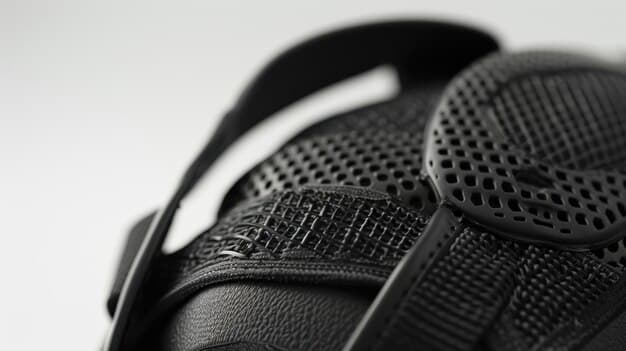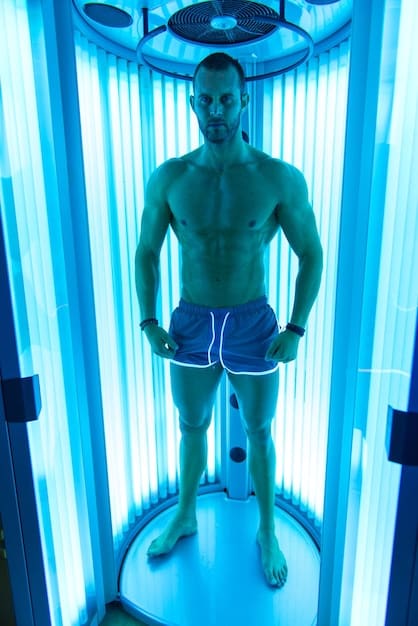Sports Innovations: Boosting Performance & Safety

The latest innovations in sports equipment and technology are continuously enhancing athletic performance and safety through advanced materials, smart devices, and data analytics, providing athletes with unprecedented advantages and protection.
For athletes and enthusiasts alike, the question of What are the Latest Innovations in Sports Equipment and Technology That Are Improving Athletic Performance and Safety? is constantly evolving. From the tracks to the fields, and from the courts to the slopes, new breakthroughs are reshaping how sports are played, trained for, and experienced. This exploration delves into the cutting-edge advancements driving these transformations.
Revolutionizing Performance Through Advanced Materials
The foundation of modern sports equipment often begins with groundbreaking materials science. Engineers and designers are constantly seeking lighter, stronger, and more responsive composites that can give athletes an edge, while also ensuring durability and safety. This pursuit leads to significant performance gains across various disciplines.
The Rise of Carbon Fiber and Graphene
Carbon fiber has long been a staple in high-performance sports equipment, known for its exceptional strength-to-weight ratio. Its application ranges from bicycle frames and tennis rackets to golf club shafts and rowing shells, significantly reducing weight without compromising structural integrity. This allows for faster movements, less fatigue, and more precise control. Graphene, a relatively newer material, is now emerging as an even more revolutionary alternative. Only one atom thick, it is the strongest material known to exist, incredibly lightweight, and highly conductive.
* Cycling: Ultra-light carbon fiber frames and wheels reduce rotational mass, enabling faster acceleration and climbing.
* Tennis/Badminton: Carbon fiber rackets offer increased power and control due to their stiffness and vibration dampening properties.
* Golf: Shafts made from advanced carbon composites improve swing speed and shot accuracy.
Graphene’s potential extends to everything from stronger, more flexible running shoes that enhance energy return to skis that are both lighter and incredibly stable. Research is also exploring its use in protective gear, offering unparalleled impact resistance with minimal bulk.
The synthesis of these materials with traditional ones, or the creation of hybrid composites, allows for a fine-tuning of properties. For example, skis might incorporate different densities of carbon fiber in specific areas to optimize flex patterns and torsional rigidity, adapting the equipment to specific demands of the sport and athlete. This granular control over material properties is a hallmark of current innovation. Furthermore, the manufacturing processes are becoming more sophisticated, allowing for intricate designs and seamless integration of different components for optimal performance and structural integrity.
Smart Wearables and Biometric Data Integration
The convergence of sports and technology is nowhere more evident than in the proliferation of smart wearables. These devices collect a wealth of biometric data, providing athletes and coaches with unprecedented insights into performance, recovery, and potential injury risks.
Modern smartwatches, heart rate monitors, and specialized sensors offer real-time feedback on critical metrics. These devices go beyond basic heart rate tracking, now measuring everything from blood oxygen levels and skin temperature to stride length and ground contact time. The data collected can be aggregated and analyzed by sophisticated software, identifying patterns and areas for improvement that were previously impossible to discern. This allows for highly personalized training regimens.
Real-time Feedback and Training Optimization
The ability to receive instant feedback during training sessions is a game-changer. For runners, sensors embedded in shoes or worn on the body can analyze gait mechanics, alerting them to potential inefficiencies or movements that could lead to injury. Swimmers can use devices that track stroke count, pace, and efficiency, allowing them to adjust their technique mid-session.
* Running: GPS watches with advanced metrics like vertical oscillation and pronation provide insights for efficient stride.
* Swimming: Goggles with integrated displays show real-time metrics like lap times and stroke rate, aiding in immediate technique adjustments.
* Team Sports: Wearable GPS trackers for team sports monitor player workload, distance covered, and high-intensity efforts, helping coaches manage fatigue and peak performance.
This data-driven approach removes much of the guesswork from training. Athletes can see immediate correlations between their effort and objective measures, fostering a deeper understanding of their bodies and how to optimize their output. The integration of artificial intelligence into these analytics platforms further enhances their utility, predicting performance trends and suggesting tailored adjustments to training plans based on individual responses to various stimuli. This level of precision was once reserved for elite professional teams, but is now becoming increasingly accessible to amateur athletes as well.
Revolutionizing Safety: Protective Gear and Concussion Prevention
While pushing the boundaries of performance, innovation in sports equipment also places paramount importance on athlete safety. New materials and designs are leading to more effective protective gear, particularly in sports with high impact risks. The focus has shifted from merely absorbing impact to actively mitigating concussions and other serious injuries.
Advanced Helmet Technology and Impact Absorption
Concussion prevention is at the forefront of sports safety research, particularly in contact sports like football, hockey, and cycling. Helmets are no longer just basic foam and shell; they incorporate multi-directional impact protection systems (MIPS), fluid-filled layers, and innovative padding that dissipate rotational forces, which are often implicated in concussions. These advancements aim to reduce the G-forces transferred to the brain during impacts from various angles.
New materials like non-Newtonian fluids (materials that change viscosity under stress) are being integrated into padding, offering dynamic protection that hardens upon impact to absorb energy more effectively. Additionally, some helmets contain sensors that can detect impacts and alert medical staff to potential concussions, allowing for immediate assessment and removal from play, thereby preventing further injury to an already compromised athlete.
* Football/Hockey: Helmets with multi-density padding and slip-plane layers (like MIPS) reduce rotational forces on the brain during oblique impacts.
* Cycling: Helmets are designed with improved ventilation and lighter, stronger materials for enhanced comfort and protection.
* Soccer: Headgear designed to reduce the impact from headers is gaining traction, though debate continues on its efficacy and necessity.
Beyond helmets, body armor in sports like motocross and snowboarding utilizes similar principles of progressive impact absorption. Guards are designed to distribute force over a larger area and slowly deform to cradle the body, limiting localized trauma. The integration of real-time monitoring systems into protective gear, providing alerts on excessive force or repeated impacts, marks a significant leap in preventive care, moving safety from reactive to proactive. This holistic approach ensures that athletes are not only performing at their best but are also safeguarded against the inherent risks of intense physical activity.

Data Analytics and Performance Tracking Systems
The collection of data in sports has moved beyond simple statistics; it now involves sophisticated analytics platforms that track every conceivable aspect of performance, both individually and within a team context. This wealth of information is being leveraged by coaches, trainers, and even athletes themselves to gain a competitive edge.
From Raw Data to Actionable Insights
Wearable sensors, high-speed cameras, and GPS tracking systems generate massive amounts of raw data. The real innovation lies in the analytical tools that transform this data into actionable insights. Machine learning algorithms can identify subtle trends, predict athlete fatigue, or even pinpoint specific technical flaws that traditional coaching might miss. For instance, in basketball, tracking systems can analyze player movement patterns, shot selection, and defensive positioning in real-time, providing coaches with immediate strategic adjustments.
In track and field, sophisticated camera systems coupled with motion analysis software can break down every fraction of a second of a sprint or jump, identifying critical points for improvement in technique. This granular level of analysis allows athletes to refine their movements with extraordinary precision, leading to marginal gains that can often translate into significant competitive advantages.
* Team Sports: GPS vests track player movement, speed, and acceleration, informing training load management and tactical decisions.
* Individual Sports: Biomechanics labs use 3D motion capture to analyze technique in sports like golf, tennis, and weightlifting, optimizing form for power and injury prevention.
* Performance Prediction: AI models analyze historical data to predict injury risk, optimize recovery schedules, and forecast peak performance windows.
The advent of cloud-based platforms means that this data can be accessed and analyzed from anywhere, facilitating remote coaching and cross-team collaboration. This systematic approach to performance enhancement, grounded in empirical data, is setting new standards for athletic potential. The ability to visualize and understand complex data sets through intuitive dashboards empowers both athletes and coaches to make informed decisions swiftly, turning abstract numbers into tangible improvements on the field or court.
Innovation in Recovery and Rehabilitation
Performance and safety aren’t just about what happens during competition or training; they extend to how athletes recover and rehabilitate from injuries. Technology is playing an increasingly vital role in accelerating recovery times, preventing re-injury, and optimizing an athlete’s return to play.
Advanced Therapies and Smart Diagnostics
Cryotherapy, hyperbaric oxygen therapy chambers, and targeted compression garments are becoming standard tools in top-tier athletic recovery centers. These therapies aim to reduce inflammation, promote cellular repair, and enhance circulation, thereby speeding up the body’s natural healing processes after strenuous activity or injury. Beyond these physical therapies, smart diagnostic tools are transforming the rehabilitation process. Sensor-based systems can objectively measure range of motion, muscle strength, and balance, providing precise data on an athlete’s recovery progress.
For example, smart insoles can monitor changes in foot pressure and gait patterns post-injury, alerting physical therapists to asymmetries or compensations that could lead to further issues. Virtual reality (VR) and augmented reality (AR) are also emerging as powerful tools in rehabilitation, offering engaging and measurable exercises that can simulate sport-specific movements in a controlled environment, helping athletes regain confidence and motor skills.
* Compression Therapy: Garments with sequential compression facilitate lymphatic drainage and reduce muscle soreness.
* Cold/Heat Therapy: Automated systems provide precise temperature control for injury-specific application, reducing swelling and promoting blood flow.
* Biofeedback Devices: Sensors that provide real-time feedback on muscle activation help athletes re-learn proper movement patterns after injury.
The goal is to not only get athletes back to their sport but to ensure they return stronger and less susceptible to future injuries. This proactive approach to well-being, supported by technological advancements, underscores a holistic view of athletic development, where recovery is as critical as training itself. The detailed data collected during rehabilitation also helps build comprehensive profiles for each athlete, informing long-term strategies for injury prevention and career longevity.

Emerging Technologies: AI, VR, and Robotics in Sports
Looking forward, artificial intelligence (AI), virtual reality (VR), and robotics are poised to further revolutionize sports, moving beyond incremental improvements to fundamentally change how athletes train, analyze, and even interact with their equipment. These technologies offer immersive, personalized, and efficient pathways to athletic excellence.
Training Simulations and Personalized Coaching with AI/VR
AI is transforming coaching by analyzing vast datasets of athlete performance, opponent strategies, and environmental factors to identify optimal game plans and customized training regimens. AI-powered video analysis systems can provide instant, objective feedback on technique, identifying minute flaws that human coaches might miss. Imagine an AI coach that can analyze a tennis player’s serve, compare it to thousands of professional serves, and then provide specific, actionable tips for improvement.
Virtual reality offers immersive training simulations that replicate real-game scenarios without physical risk. For example, a quarterback can practice reading defenses in realistic VR environments, experiencing different pressure situations and improving decision-making speed without the wear and tear of actual practice. Similarly, gymnasts can rehearse complex routines in VR, fine-tuning their movements and spatial awareness.
* AI in Scouting: Algorithms analyze player statistics and video to identify untapped talent and assess potential contributions to a team.
* VR for Scenario Training: Athletes can practice high-pressure situations, such as free throws in a packed arena or penalty kicks, in a controlled virtual environment.
* Robotics in Equipment: Automated ball machines with advanced trajectory control for precise repetitive training in sports like tennis or baseball.
Robotics, while perhaps less visible, plays a critical role in developing and testing equipment, as well as in providing highly controlled training environments. Robotic systems can repeatedly execute specific movements to test equipment durability or simulate repetitive actions for athletes, ensuring consistency and safety. The fusion of these technologies promises a future where athletic potential is unlocked through highly personalized, data-driven, and engaging training experiences. This next wave of innovation will not only push human limits but will also make high-level training more accessible and safer for a broader range of athletes.
The Future of Sports: Integration and Accessibility
The trajectory of sports innovation points towards an increasingly integrated and accessible future. The current individual advancements across materials, wearables, data analytics, safety, and rehabilitation are converging, creating a holistic ecosystem that supports athletes at every stage of their journey. This integration means that equipment, training methodologies, and recovery protocols will work in concert, forming a seamless and adaptable framework.
Looking ahead, sports technology will likely become more democratized. What is currently elite-level equipment or training may become standard for amateur athletes, driven by mass production, miniaturization of components, and more affordable analytical software. This accessibility will empower a wider population to experience the benefits of advanced sports science, fostering greater participation and potentially identifying talent in unexpected places.
Furthermore, personalized medicine and predictive analytics will become even more sophisticated, moving towards hyper-individualized training and injury prevention plans based on an athlete’s unique genetic predispositions, physiological responses, and psychological profile. Imagine a world where your athletic gear automatically adjusts its properties based on your real-time fatigue levels, or where an AI companion diagnoses a potential overtraining risk days before symptoms manifest.
The environmental impact of sports equipment manufacturing is also a growing concern, and future innovations will undoubtedly focus on sustainable materials and production processes. Biodegradable composites, recycled materials, and energy-efficient manufacturing will become design imperatives, aligning athletic performance with ecological responsibility. Ultimately, the future of sports equipment and technology is not just about faster, stronger, or safer. It’s about creating an intelligent, responsive, and sustainable environment where every athlete, regardless of their level, can optimize their potential and enjoy their passion to the fullest, minimizing risks and maximizing enjoyment. This holistic approach ensures that the pursuit of excellence is balanced with well-being and environmental consciousness.
| Key Innovation | Impact on Performance & Safety |
|---|---|
| ⚡ Advanced Materials | Lighter, stronger carbon fiber and graphene composites enhance speed, agility, and control while adding durability. |
| ⌚ Smart Wearables | Real-time biometric data and performance tracking optimize training, prevent overtraining, and monitor recovery. |
| ⛑️ Enhanced Protective Gear | Multi-directional impact systems (MIPS) and advanced padding in helmets and body armor reduce concussion risk and improve overall safety. |
| 📊 Data Analytics & AI | Transforms raw data into actionable insights for personalized coaching, tactical adjustments, and injury prediction. |
Frequently Asked Questions About Sports Technology
▼
Graphene, known for its exceptional strength and lightness, is being integrated into performance gear to create more durable yet flexible products. It enhances energy return in shoes, increases stiffness in rackets, and can provide superior impact resistance in protective gear, leading to improved athletic efficiency and reduced risk of equipment failure.
▼
Smart wearables track a wide array of data points, including heart rate, sleep patterns, skin temperature, GPS location, speed, acceleration, and specific biomechanical metrics like stride length or stroke efficiency. This data is used by athletes and coaches to personalize training loads, optimize recovery, identify performance plateaus, and adjust techniques for peak performance.
▼
New helmet technologies like Multi-directional Impact Protection Systems (MIPS) incorporate a low-friction layer designed to allow a helmet’s outer shell to slide relative to the head during an oblique impact. This mimics the brain’s own protective cerebrospinal fluid, reducing rotational forces transferred to the brain, which are often linked to concussions, thereby significantly enhancing safety.
▼
Innovations are enhancing recovery through advanced therapies like cryotherapy, hyperbaric chambers, and targeted compression, which reduce inflammation and promote healing. Smart diagnostic tools provide objective data on recovery progress, while VR and AR can offer engaging, controlled rehabilitation exercises, helping athletes return to play stronger and with less risk of re-injury.
▼
AI will revolutionize coaching by offering highly personalized training plans, advanced predictive analytics for performance and injury, and automated technical feedback. VR will provide immersive, low-risk training simulations for practicing game scenarios and refining motor skills, allowing athletes to gain critical experience and decision-making abilities in virtual environments, pushing performance boundaries.
Conclusion
The relentless pace of innovation in sports equipment and technology is undeniably transforming the athletic landscape. From groundbreaking materials that enhance performance and durability to sophisticated wearables that offer unprecedented insights into human physiology, and from advanced protective gear that prioritizes athlete safety to intelligent systems for recovery and rehabilitation, the future of sports is intrinsically linked to technological progress. These advancements are not merely about marginal gains; they fundamentally redefine what is possible, empowering athletes to push their limits while offering a more secure and data-driven approach to their well-being. As these technologies continue to integrate and become more accessible, they promise a future where athletic excellence is more attainable, safer, and more precisely optimized than ever before.





